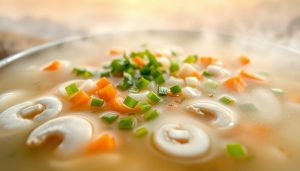Jasmine rice is the perfect side dish for all kinds of Thai foods, including ground meats, spicy curries or grilled. The stickiness and sweetness of jasmine rice make it an ideal alternative to regular white rice. Moreover, you can make perfect jasmine rice quickly and easily in a rice cooker just as you would with traditional white rice. In this article, I’ve added a step by step guideline on “How to Cook Jasmine Rice in a Rice Cooker”. Let’s check it out to cook your favorite rice properly.
What is Jasmine Rice?

Jasmine rice is originally from Thailand and is mostly used in Southeast Asia cooking. This is a long-grain variety of rice that has a nutty flavor and a soft, sticky texture when cooked. The grains are thicker and shorter than Basmati Rice. Additionally, this rice is about three times stickier than American long-grain rice. There are two types of jasmine rice available, white and brown. When it comes to health, brown jasmine rice has greater health benefits than white jasmine rice. Jasmine Rice Pricing.
Ingredients that You Need
The following ingredients you’ll need for cooking jasmine rice in a rice cooker.
[su_list icon=”icon: hand-o-right” icon_color=”#EE3322″]
- 2 cups of Jasmine rice
- 2.4 cup of water for cooking and
- Rice cooker
- Wooden spatula [/su_list]
Steps on How to Cook Jasmine Rice in a Rice Cooker
It is easy to cook jasmine rice using a rice cooker. It requires less effort and time so you wouldn’t need to stand for hours near your gas stove. However, there is the best way to cook jasmine rice using a rice cooker.
Step 01: Wash the Rice

To wash the rice, add two cups of jasmine rice to the rice cooker. Fill the pot with enough cold pure water to cover the rice by at least an inch. Use your hand to gently agitate the rice for 3 to 5 minutes. This will help to remove some of the dirt and starch on the outside of the rice. Continue rinsing the rice until the water is mostly clear, about 2 to 3 times. But I washed for only once as manufactured instruction. Now use a colander or strainer to free the rice from water. Shake the rice well to remove the excess water.
Step 02: Add the Rice and Enough Amount of Water to the Rice Cooker

Once the jasmine rice is clean, place it inside the pot of the rice cooker. After that, pour one cup of clean and cold water over the rice. For jasmine rice, it is best to use a 1:1 ratio of rice to water. But you must remember that the Jasmine rice to water ratio always will not be 1:1. It may be changed on several facts like Rice origin, rice cooker, cooking time, etc.
For me, I have used Royal Umbrella Thai Jasmine Rice and the water ratio for this rice is 1:1.2. That mean’s, I have to use 1.2 cups of water for 1 cup of Jasmine rice. Anyway, I have added 2.4 cups of water for 2 cups of Jasmine rice.
Step 03: Mix a Little Amount of Salt

If you’d like to season the rice before it cooks, you can add ½ teaspoon of salt to the rice cooker. Use a wooden spoon to stir the salt into the rice and water so all of the ingredients are well-mixed. However, adding the salt is an additional step, you can skip it if you want.
Note: I haven’t used any salt during cooking.
Step 04: Turn on The Rice Cooker
Once you have mixed the rice, water, and salt in the rice cooker, put the lid on and turn on the rice cooker. The cooking time depends on the rice cooker brands and their capacity for boiling. The standard time for cooking jasmine rice properly is 20-30 minutes depending on how much rice you are cooking. After turning the rice cooker on, it will automatically go to the “Keep Warm” mode when cooking is done. Once this is done, keep the rice cooker in the “Keep Warm” mode for 10-15 minutes.
Step 05: Let the Rice to Rest for at Least 10 Minutes
Allow the rice to rest for at least 10 to 15 minutes. Do not remove the rice from the cooker. Make sure to leave the lid on the cooker when the rice is resting.
Step 06: Fluff the Rice with a Wooden Spatula
Once the rice has rested for several minutes, mix the rice up a bit using a wooden spatula. This will help to remove any lingering moisture and give the rice a fluffier texture.
Step 07: It’s Time to Serve

After you have fluffed the rice, use the spatula to carefully put it in a bowl. Serve the rice to your family while it is still warm as a side to your favorite meat main course.
Comparing Jasmine Rice with Others
Jasmine Rice Vs White Rice
One of the main differences between jasmine and white rice is how they look and smell. White rice is very sticky and often used in Asian dishes. It can have either a short, medium or long grain, while jasmine rice has only a long grain. However, they have a distinct similarity also. Both are processed and have its husk, bran, and germ removed. This means both of the rice are stripped of many nutrients, including fiber. Jasmine Rice Pricing. White Rice Pricing.
Basmati Rice Vs Jasmine Rice
It is very easy to confuse raw basmati and jasmine rice. Both of them are long-grain varieties, and both contain a compound that can give them a popcorn-like aroma. However, they have some remarkable differences also between them. Basmati rice hails from the foothills of the Himalayas in Pakistan and northern India. This is long-grain rice mostly used in Indian, Middle Eastern, and Persian cooking.
Jasmine rice, on the other hand, is a very fragrant long-grain rice from Thailand. It has a subtle floral aroma and commonly used in Southeast Asian dishes. Jasmine Rice Pricing. Basmati Rice Pricing.
Is Jasmine Rice Good for You?
A 1/4-cup serving of dry jasmine rice has 160 calories, 36 grams of carbohydrates, 3 grams of protein, and less than 1 gram of fat, which is about the same amount found in a 1/4-cup serving of dry long-grain white rice. They each also have only 1 gram of fiber and minor amounts of vitamins A, C and D, and iron. When it is about your health, you’re not getting any extra benefits by switching to jasmine rice. However, you can add a little extra nutrition to your diet using brown jasmine rice instead of white. Because of whole grain, the brown rice version retains its bran and germ that automatically ups the fiber and nutrient content.
Last Thought
All rice cooker brands provide a guideline on to use their products. Make sure that you have checked the guideline (especially temperature setting) before using the rice cooker. Finally, one more tip for you never takes the lid off the rice cooker to check on the jasmine rice when it’s cooking. This can slow down the Jasmine rice cooking process or leave you with chewy rice. Rice Cooker Pricing.
Useful Resources
- How to Make Jasmine Rice – WikiHow
- What’s the Difference Between Jasmine Rice and White Rice? – Healthline


